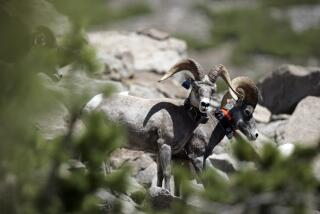Reno Struggles With Flocks of Flight-Threatening Geese
- Share via
RENO — This city’s growing goose population will quintuple this winter as the migratory birds traveling the Pacific Flyway make their home in the gambling mecca instead of continuing south, wildlife experts say.
As a result, Reno Cannon International Airport and Department of Agriculture officials are taking steps to keep the geese from flying near planes and to get them to continue through Reno to warmer regions.
“Normally, the Canada geese that nest in Alberta come down to the Great Salt Lake and then turn west, going through Reno,” said Steve Fairaizl, wildlife biologist with the U.S. Department of Agriculture’s Animal Damage Control Division.
“They used to go on to the Central Valley in California, but now a lot of them are staying in Reno for the winter. Reno’s really become quite an attractive place for the geese over the years.”
Fairaizl said new regional parks such as Rancho San Rafael have created cozy resting places for the 6,000 migrating geese that now winter in Reno and 1,500 geese that live in the city full time. Reno’s relatively mild winters are expected to attract larger numbers of the birds over the next few years, he said.
“I think a program of hazing or harassing the geese and transplanting some will control the population for another three or four years, but then the problem could become worse,” Fairaizl said.
Earlier this year, the Agriculture Department transplanted 315 geese to California and Idaho from Reno in an effort to cut down the local population. Fairaizl said his agency planned to try to chase geese away with firecrackers and model airplanes.
Last spring, operators of Bally’s Reno spent $9,000 to set up a wire grid system over the resort’s lake, where geese were stopping to drink and flying into the paths of planes using the airport runways just 1 1/2 miles away.
Rick Peacock, spokesman for the airport which requested the grid, said the wires strung at about three-foot intervals appear to be working to keep the geese from stopping at the lake after feeding at the University of Nevada, Reno experimental farm east of McCarran Boulevard.
“It used to be that the geese pattern was to feed at the university farm and then fly across the airport to Bally’s lake,” Peacock said. “It looks like we’ve disrupted that dangerous pattern, but it’s still too early to tell how successful this will be.”
The airport also uses a harassment program to scare away geese with loud noises when the birds threaten to disrupt flights.
Peacock said that during the last three years there have been three major incidents at the Reno airport in which collisions with geese have caused $250,000 in damages to planes. Another six minor incidents were reported.
“We’ve been lucky because there have been no human lives lost or people injured,” Peacock said. “But it is a serious problem that has caused fatalities at other airports.”
If a bird flies into a plane’s engine, the aircraft could lose power and crash, Peacock said.
A task force made of up officials of wildlife and animal protection groups and the airport was formed nearly two years ago in Reno to propose solutions to control the goose population, Fairaizl said.
On the East Coast, where some cities contend with hundreds of thousands of annoying geese, officials have started to destroy eggs, he added, arguing that the only predators the birds have left are humans who hunt.
More to Read
Sign up for Essential California
The most important California stories and recommendations in your inbox every morning.
You may occasionally receive promotional content from the Los Angeles Times.













